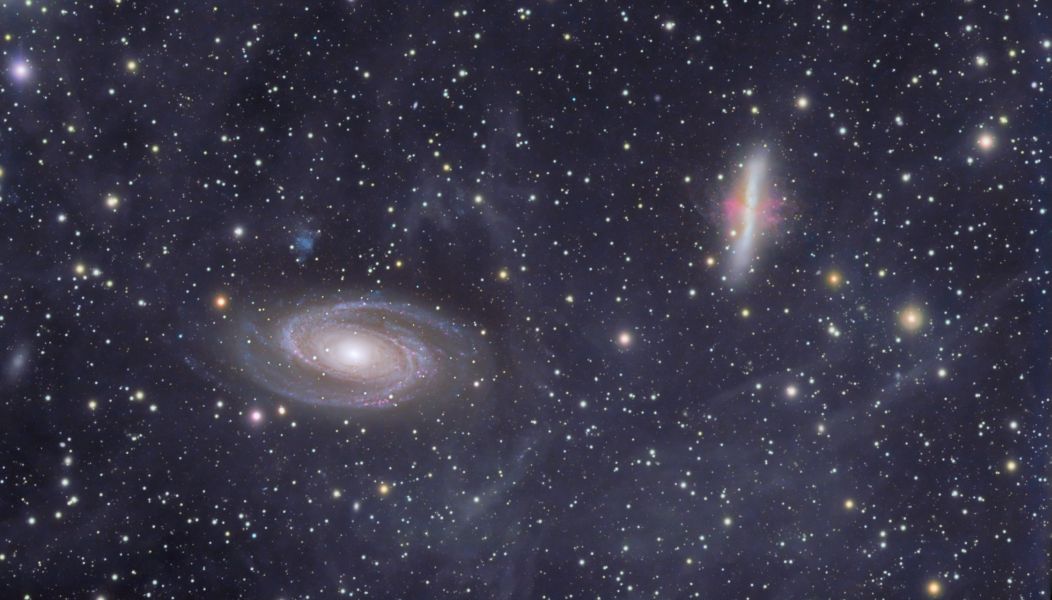M81 and M82: A Galactic Waltz |
 |
| The Galactic duo of M81 and M82 can be found in
a region of the sky close to the bowl of the famous Big Dipper.
While this pair can be described as being “close” to the Big
Dipper, they are actually galaxies outside our own Milky Way and
sit about 12 million light-years away. In comparison, the stars
of the Big Dipper lie “only” about 80-90 light-years away. M81 and M82 are trapped in a gravitational waltz. The immense collective gravity of the billions of stars within these galaxies has caused them to pull on each other. They had a close encounter with each other a few tens of millions of years ago, resulting in some perturbations in the spiral shape of M81, and triggered star formation in M82. The effect on M82 is especially visible as the red filaments emanating from its center – possibly the result of hot winds from supernovas spawned with the star formation. This waltz will continue with the galaxies circling and closing with each other for eons. Eventually, the dance will end in a grand merger of the two galaxies to form an even bigger galaxy. For now, we can watch the waltz from a safe distance. M81 and M82 can easily be seen with a small telescope. With a low-power eyepiece, the two can even fit within the field of view of a telescope. In a dark enough sky, they can be seen with binoculars. This image, updated for 2011, showcases the galaxies through portions of the Integrated Flux Nebula. This nebular complex, explored by Steve Mandel in 2004, is a huge cloud of gas and dust above the plane of our Milky Way Galaxy, reflecting light not from individual stars, but light from the entire galaxy! It is relatively faint, and only shows up in long exposures taken from very dark skies. This updated image was shot from our new remote observatory located at a very dark site in New Mexico, a village designed for astronomers called Rancho Hidalgo. In addition to the main galaxies and the Integrated Flux Nebula, visible in this image are M81's companion galaxy Holmberg IX (the bluish object to M81's upper left) as well as PGC 28731, the faint galaxy at the center left edge of the image. There may be other faint background galaxies visible in this wide field image. Feel free to look around! A prior image of this duo, last acquired in 2005, can be seen here. |
| Object: M81 and M82 |
| Constellation: Ursa Major |
| When Visible: January - July |
| Distance: 12 Million Light-years |
| Dates taken: February-March 2011 |
| Location: Rancho Hidalgo, New Mexico |
| Exposure Details:
L: 63 x 10 Minutes, binned 1x1 R: 15 x 10 minutes, binned 1x1 G: 15 x 10 minutes, binned 1x1 B: 15 x 10 minutes, binned 1x1 18 hours total exposure |
| Equipment Used: Takahashi TOA-130F with flattener on an Astro-Physics 1200GTO mount. SBIG STL-6303 camera with STL-FW8 filter wheel and Astrodon LRGB filters |
| Acquisition Software : MaximDL 5, CCDAutopilot 4 |
| Processing Software: MaximDL, Adobe Photoshop CS4, Gradient Xterminator, Noise Ninja, Carboni Tools, IrFanView |
